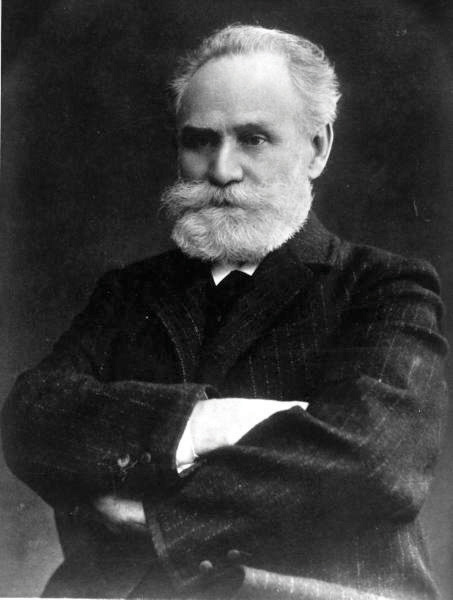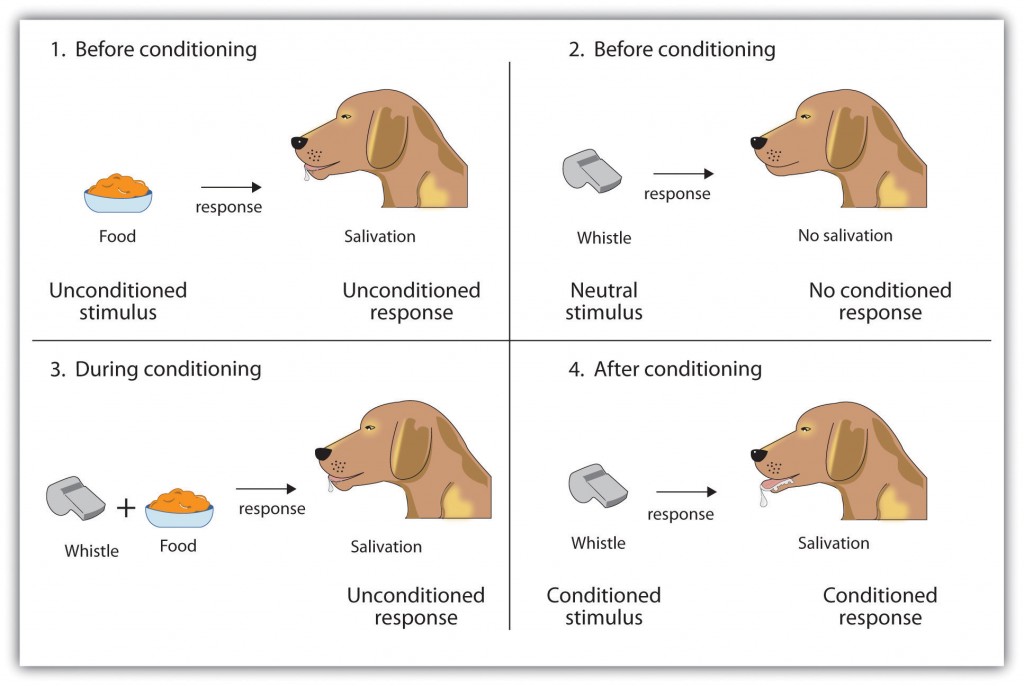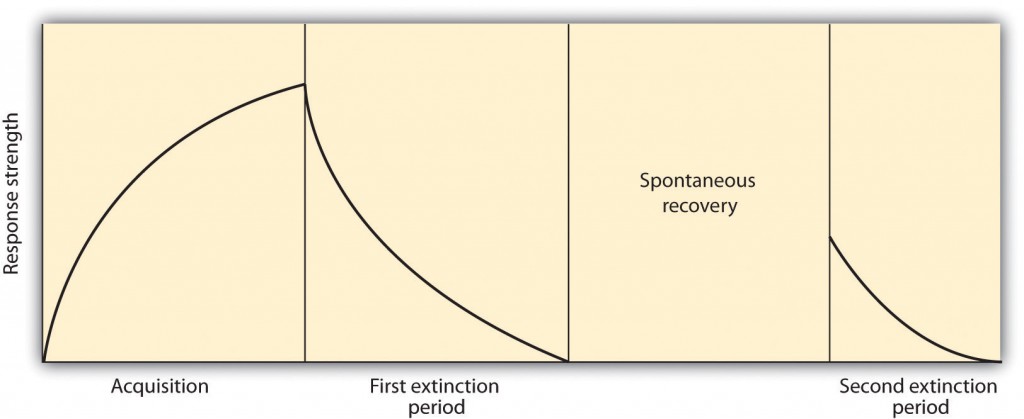Which Of The Following Responses Is Probably Learned Through Classical Conditioning?
Chapter 8. Learning
8.i Learning by Association: Classical Conditioning
Learning Objectives
- Describe how Pavlov's early on piece of work in classical conditioning influenced the understanding of learning.
- Review the concepts of classical conditioning, including unconditioned stimulus (United states), conditioned stimulus (CS), unconditioned response (UR), and conditioned response (CR).
- Explicate the roles that extinction, generalization, and discrimination play in conditioned learning.
Pavlov Demonstrates Conditioning in Dogs
In the early on part of the 20th century, Russian physiologist Ivan Pavlov (1849-1936), shown in Figure 8.ii, was studying the digestive system of dogs when he noticed an interesting behavioural phenomenon: the dogs began to salivate when the lab technicians who normally fed them entered the room, fifty-fifty though the dogs had non yet received whatsoever food. Pavlov realized that the dogs were salivating because they knew that they were about to be fed; the dogs had begun to acquaintance the arrival of the technicians with the nutrient that soon followed their advent in the room.

With his team of researchers, Pavlov began studying this process in more detail. He conducted a series of experiments in which, over a number of trials, dogs were exposed to a sound immediately before receiving food. He systematically controlled the onset of the audio and the timing of the delivery of the food, and recorded the corporeality of the dogs' salivation. Initially the dogs salivated only when they saw or smelled the food, merely later several pairings of the sound and the nutrient, the dogs began to salivate equally shortly as they heard the audio. The animals had learned to associate the sound with the food that followed.
Pavlov had identified a central associative learning process chosen classical workout. Classical conditioning refers to learning that occurs when a neutral stimulus (east.g., a tone) becomes associated with a stimulus (east.yard., food) that naturally produces a behaviour. After the association is learned, the previously neutral stimulus is sufficient to produce the behaviour.
As you tin run into in Figure 8.three, "4-Console Epitome of Whistle and Dog," psychologists utilize specific terms to identify the stimuli and the responses in classical conditioning. The unconditioned stimulus (United states) is something (such as food) that triggers a naturally occurring response, and the unconditioned response (UR) is the naturally occurring response (such every bit salivation) that follows the unconditioned stimulus. The conditioned stimulus (CS) is a neutral stimulus that, after being repeatedly presented prior to the unconditioned stimulus, evokes a similar response equally the unconditioned stimulus. In Pavlov's experiment, the sound of the tone served as the conditioned stimulus that, after learning, produced the conditioned response (CR), which is the acquired response to the formerly neutral stimulus. Note that the UR and the CR are the same behaviour — in this case salivation — but they are given different names because they are produced past different stimuli (the United states and the CS, respectively).

Conditioning is evolutionarily benign because information technology allows organisms to develop expectations that help them prepare for both good and bad events. Imagine, for instance, that an animal first smells a new food, eats it, and so gets sick. If the beast can learn to associate the smell (CS) with the food (U.s.a.), it will quickly learn that the food creates the negative effect and will non eat it the next fourth dimension.
The Persistence and Extinction of Conditioning
After he had demonstrated that learning could occur through association, Pavlov moved on to written report the variables that influenced the forcefulness and the persistence of conditioning. In some studies, after the conditioning had taken place, Pavlov presented the sound repeatedly simply without presenting the food afterward. Figure 8.iv, "Conquering, Extinction, and Spontaneous Recovery," shows what happened. Equally y'all tin can see, afterwards the initial acquisition (learning) phase in which the conditioning occurred, when the CS was then presented solitary, the behaviour chop-chop decreased — the dogs salivated less and less to the sound, and somewhen the audio did non elicit salivation at all. Extinction refers to the reduction in responding that occurs when the conditioned stimulus is presented repeatedly without the unconditioned stimulus.

Although at the end of the first extinction menses the CS was no longer producing salivation, the effects of conditioning had not entirely disappeared. Pavlov institute that, after a intermission, sounding the tone once again elicited salivation, although to a bottom extent than before extinction took place. The increment in responding to the CS post-obit a pause subsequently extinction is known as spontaneous recovery. When Pavlov over again presented the CS alone, the behaviour over again showed extinction until it disappeared again.
Although the behaviour has disappeared, extinction is never complete. If workout is again attempted, the animal volition acquire the new associations much faster than it did the first time.
Pavlov also experimented with presenting new stimuli that were like, simply not identical, to the original conditioned stimulus. For example, if the canis familiaris had been conditioned to being scratched earlier the food arrived, the stimulus would be changed to being rubbed rather than scratched. He found that the dogs also salivated upon experiencing the similar stimulus, a process known as generalization. Generalization refers to the tendency to respond to stimuli that resemble the original conditioned stimulus. The ability to generalize has important evolutionary significance. If we eat some red berries and they make united states ill, it would be a good idea to think twice before we eat some majestic berries. Although the berries are not exactly the same, they nevertheless are similar and may have the same negative backdrop.
Lewicki (1985) conducted research that demonstrated the influence of stimulus generalization and how quickly and easily it can happen. In his experiment, high schoolhouse students showtime had a brief interaction with a female experimenter who had short hair and glasses. The written report was fix so that the students had to ask the experimenter a question, and (according to random consignment) the experimenter responded either in a negative way or a neutral fashion toward the students. So the students were told to go into a second room in which two experimenters were present and to approach either 1 of them. However, the researchers arranged information technology so that one of the ii experimenters looked a lot like the original experimenter, while the other one did not (she had longer hair and no glasses). The students were significantly more likely to avert the experimenter who looked like the before experimenter when that experimenter had been negative to them than when she had treated them more neutrally. The participants showed stimulus generalization such that the new, similar-looking experimenter created the aforementioned negative response in the participants as had the experimenter in the prior session.
The flip side of generalization is discrimination — the tendency to reply differently to stimuli that are similar only not identical. Pavlov's dogs quickly learned, for example, to salivate when they heard the specific tone that had preceded food, but non upon hearing similar tones that had never been associated with food. Discrimination is likewise useful — if we practice try the purple berries, and if they do non make us sick, we will exist able to make the stardom in the future. And we can learn that although two people in our grade, Courtney and Sarah, may look a lot alike, they are yet different people with different personalities.
In some cases, an existing conditioned stimulus tin serve as an unconditioned stimulus for a pairing with a new conditioned stimulus — a process known as second-order conditioning. In i of Pavlov'south studies, for instance, he first conditioned the dogs to salivate to a audio and then repeatedly paired a new CS, a blackness square, with the sound. Eventually he constitute that the dogs would salivate at the sight of the blackness foursquare alone, fifty-fifty though it had never been direct associated with the nutrient. Secondary conditioners in everyday life include our attractions to things that stand for or remind us of something else, such every bit when nosotros feel good on a Friday considering information technology has become associated with the paycheque that we receive on that day, which itself is a conditioned stimulus for the pleasures that the paycheque buys u.s..
The Role of Nature in Classical Conditioning
As we accept seen in Chapter ane, "Introducing Psychology," scientists associated with the behaviourist school argued that all learning is driven past feel, and that nature plays no part. Classical conditioning, which is based on learning through feel, represents an instance of the importance of the environment. But classical workout cannot be understood entirely in terms of experience. Nature also plays a part, as our evolutionary history has fabricated us better able to larn some associations than others.
Clinical psychologists make apply of classical conditioning to explicate the learning of a phobia — a strong and irrational fright of a specific object, activity, or situation. For example, driving a car is a neutral event that would not normally elicit a fear response in almost people. But if a person were to experience a panic assail in which he or she of a sudden experienced potent negative emotions while driving, that person may learn to associate driving with the panic response. The driving has get the CS that now creates the fearfulness response.
Psychologists have also discovered that people practice not develop phobias to just anything. Although people may in some cases develop a driving phobia, they are more probable to develop phobias toward objects (such as snakes and spiders) or places (such as high locations and open spaces) that have been dangerous to people in the by. In modernistic life, it is rare for humans to be bitten by spiders or snakes, to fall from trees or buildings, or to exist attacked by a predator in an open area. Being injured while riding in a automobile or existence cut by a knife are much more likely. But in our evolutionary by, the potential for being bitten by snakes or spiders, falling out of a tree, or existence trapped in an open space were important evolutionary concerns, and therefore humans are still evolutionarily prepared to learn these associations over others (Öhman & Mineka, 2001; LoBue & DeLoache, 2010).
Another evolutionarily of import blazon of conditioning is conditioning related to food. In his important research on food conditioning, John Garcia and his colleagues (Garcia, Kimeldorf, & Koelling, 1955; Garcia, Ervin, & Koelling, 1966) attempted to condition rats by presenting either a taste, a sight, or a sound as a neutral stimulus before the rats were given drugs (the US) that made them nauseous. Garcia discovered that taste conditioning was extremely powerful — the rat learned to avert the taste associated with illness, even if the illness occurred several hours later. Simply conditioning the behavioural response of nausea to a sight or a sound was much more hard. These results contradicted the idea that workout occurs entirely as a result of ecology events, such that it would occur equally for whatsoever kind of unconditioned stimulus that followed whatsoever kind of conditioned stimulus. Rather, Garcia'due south research showed that genetics matters — organisms are evolutionarily prepared to larn some associations more hands than others. You can see that the power to acquaintance smells with affliction is an important survival machinery, allowing the organism to quickly acquire to avoid foods that are poisonous.
Classical workout has too been used to help explain the experience of post-traumatic stress disorder (PTSD), as in the case of P. K. Philips described in the chapter opener. PTSD is a severe feet disorder that can develop subsequently exposure to a fearful event, such every bit the threat of expiry (American Psychiatric Association, 2000). PTSD occurs when the individual develops a potent association between the situational factors that surrounded the traumatic event (e.g., military uniforms or the sounds or smells of war) and the U.s. (the fearful trauma itself). Equally a consequence of the conditioning, existence exposed to or even thinking about the situation in which the trauma occurred (the CS) becomes sufficient to produce the CR of severe anxiety (Keane, Zimering, & Caddell, 1985).
PTSD develops because the emotions experienced during the event have produced neural activity in the amygdala and created potent conditioned learning. In addition to the strong conditioning that people with PTSD feel, they also show slower extinction in classical conditioning tasks (Milad et al., 2009). In curt, people with PTSD have developed very strong associations with the events surrounding the trauma and are likewise tiresome to testify extinction to the conditioned stimulus.
Key Takeaways
- In classical conditioning, a person or animal learns to associate a neutral stimulus (the conditioned stimulus, or CS) with a stimulus (the unconditioned stimulus, or US) that naturally produces a behaviour (the unconditioned response, or UR). Equally a consequence of this association, the previously neutral stimulus comes to elicit the same response (the conditioned response, or CR).
- Extinction occurs when the CS is repeatedly presented without the US, and the CR eventually disappears, although it may reappear later in a process known every bit spontaneous recovery.
- Stimulus generalization occurs when a stimulus that is similar to an already-conditioned stimulus begins to produce the same response as the original stimulus does.
- Stimulus discrimination occurs when the organism learns to differentiate betwixt the CS and other like stimuli.
- In 2d-order conditioning, a neutral stimulus becomes a CS afterward beingness paired with a previously established CS.
- Some stimuli — response pairs, such as those between scent and food — are more easily conditioned than others considering they have been particularly important in our evolutionary past.
Exercises and Critical Thinking
- A instructor places gilt stars on the chalkboard when the students are placidity and circumspect. Eventually, the students outset becoming quiet and circumspect whenever the instructor approaches the chalkboard. Can you explicate the students' behaviour in terms of classical workout?
- Recall a time in your life, possibly when you were a child, when your behaviours were influenced by classical workout. Describe in item the nature of the unconditioned and conditioned stimuli and the response, using the advisable psychological terms.
- If postal service-traumatic stress disorder (PTSD) is a type of classical conditioning, how might psychologists use the principles of classical conditioning to treat the disorder?
References
American Psychiatric Association. (2000).Diagnostic and statistical transmission of mental disorders (4th ed., text rev.). Washington, DC: Author.
Garcia, J., Ervin, F. R., & Koelling, R. A. (1966). Learning with prolonged delay of reinforcement.Psychonomic Science, v(iii), 121–122.
Garcia, J., Kimeldorf, D. J., & Koelling, R. A. (1955). Conditioned aversion to saccharin resulting from exposure to gamma radiation.Science, 122, 157–158.
Keane, T. Thousand., Zimering, R. T., & Caddell, J. M. (1985). A behavioral conception of posttraumatic stress disorder in Vietnam veterans.The Behavior Therapist, 8(i), nine–12.
Lewicki, P. (1985). Nonconscious biasing effects of unmarried instances on subsequent judgments.Journal of Personality and Social Psychology, 48, 563–574.
LoBue, V., & DeLoache, J. Southward. (2010). Superior detection of threat-relevant stimuli in infancy.Developmental Scientific discipline, 13(i), 221–228.
Milad, Yard. R., Pitman, R. K., Ellis, C. B., Gold, A. Fifty., Shin, 50. M., Lasko, N. B.,…Rauch, South. Fifty. (2009). Neurobiological basis of failure to call up extinction retentivity in posttraumatic stress disorder.Biological Psychiatry, 66(12), 1075–82.
Öhman, A., & Mineka, S. (2001). Fears, phobias, and preparedness: Toward an evolved module of fearfulness and fear learning.Psychological Review, 108(3), 483–522.
Epitome Attributions
Figure viii.2: Ivan Pavlov (http://commons.wikimedia.org/wiki/File:Ivan_Pavlov_LIFE.jpg) is in the public domain.
Which Of The Following Responses Is Probably Learned Through Classical Conditioning?,
Source: https://opentextbc.ca/introductiontopsychology/chapter/7-1-learning-by-association-classical-conditioning/
Posted by: nethourt1965.blogspot.com


0 Response to "Which Of The Following Responses Is Probably Learned Through Classical Conditioning?"
Post a Comment